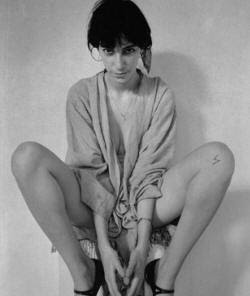Browsing through Patti Smith's Just Kids...

Patti before Smith and Robert before Mapplethorpe meet in New York City in the late 1960s.
What happens? Love. Art. Rock. And a fascinating story.
In Patti Smith’s Just Kids we see the first steps of the two young artists, from homeless youths in the heart of the big city to emerging artists in the flourishing art scene of New York of the 1970s.
It is their own Road to Ithaca; and just like in Cavafy’s poem, what is the most interesting to see is the trip, that makes their artistic and personal life experience richer, and not the end of their trip, where they both became renowned artists.
We follow them as they drift from one job to another, on their daily struggle to make enough to have a little food and art material –often having to choose between the two.
We see them fall in love and work side by side, interacting yet always keeping their individuality, that would eventually lead them two different directions.

Robert Mapplethorpe
Robert Mapplethorpe, fleeting from a strict Catholic environment arrives in New York City to study art. There he discovers the most unexpected aspects of the city and himself: a lasting love with Patti, dark alleys with hustlers, colorful bars with Andy Warhol and his friends.
Initially he seeks inspiration in art history photos and male magazines, as sources of ready made images. Searching for collage material in old photographs, little by little he becomes fascinated by photography and devotes himself to it entirely. In his photographs the human body turns into a live monument and each body part becomes the entrance to the inner secrets of the portrayed. He had a unique ability to transform something trivial, the image of a body or a flower, into the map of an unknown land.
Patti Smith felt the need to escape the limits of her early life as a factory worker to follow the steps of her heroes, painters and poets, like William Blake and Arthur Rimbaud. Something between a poet and a rebel, she tries to find a way of expression inspired by Robert, the residents of Chelsea Hotel, like William Burroughs and Sam Shepard, the rock stars that surround it, like Janis Joplin or Jimi Hendrix, and the trails of her favorite poets across the ocean, in Paris.

- Patti Smith
From her notebooks of sketches, poems and stories, she moves onto the theatrical stage, initially as an actress and then as a poet, reciting her writings under the sounds of the electric guitar. It took a slight step to get from this point onto the next level, where she discovered rock music as a way of combining performance, poetry and music.
As delightful as watching a seed grow into a flower, the readers watch the two youngsters transform into artists, discovering their sources of inspiration and the elements of their character that made them who they became. Every page, every paragraph of the book, brings to us some of the most important artists, playwrights, poets and musicians of their time. And still, the most important character is the city itself; New York City of the 1970s becomes the setting that gives to the artists freedom and constant stimulation.
It's an exceptional story, yet it's not hard for the reader to relate to it. Because it’s not a story of “becoming famous”. It’s a story of growing up, entering adulthood and searching one’s identity. It is also a story of love and friendship, that lasts through disappointments, adventures, sickness, and stretches beyond death.
A beautiful narration not limited to words; incorporating poems, images, and musical references, it breaks into the field of sound and vision.
Reading:
Patti Smith, Just Kids, Ed. Ecco, 2010
Watching:
Patti Smith: Dream of Life, 2008, Director: Steven Sebring
Listening:
Patti Smith, Horses, 1975
Patti Smith, Radio Ethiopia, 1976
Patti Smith, Easter, 1978
Surfing:
www.pattismith.net
www.mapplethorpe.org


